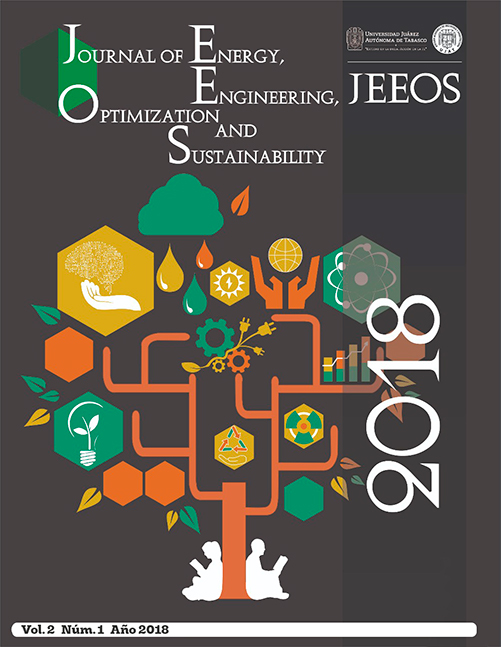ESTUDIO EXPERIMENTAL Y MATEMÁTICO DE LA DESHIDRATACIÓN DE MAÍZ CON TECNOLOGÍAS DIRECTAS Y HORNO A TEMPERATURAS CONTROLADAS
DOI:
https://doi.org/10.19136/jeeos.a2n1.2693Palabras clave:
Secador solar directo, Secado con temperaturas controladas, Convección natural, Convección forzada, Cielo abierto.Resumen
El maíz es junto con el trigo y el arroz uno de los cereales más importantes del mundo, suministra elementos nutritivos a los seres humanos y a los animales y es una materia prima básica de la industria de transformación con la que se producen almidón, aceite y proteínas, edulcorantes alimenticios y desde hace poco, combustible. Se presentan el deshidratado de maíz y la velocidad de secado utilizando horno eléctrico no convectivo con condiciones controladas de temperatura (45°C y 55°C), obteniéndose tiempos de secado de 23 y 35 horas sol respectivamente; un secador solar directo con convección natural y forzada y, cielo abierto. Los tiempos de secado obtenidos fueron 32, 40 y 50 horas sol respectivamente. La humedad inicial y final promedio fueron de 83% y 12%. Las pruebas se realizaron en el Laboratorio de Secado Solar de la Facultad de Ingeniería de la Universidad Autónoma de Campeche, localizada a 9º51'00" de LN y 90º31'59" de LO, con clima cálido-húmedo, humedad relativa promedio anual de 50% y valores de irradiancia máximos promedio de 900 W/m2. El mejor tiempo de secado alcanzado en los secadores de gabinete evaluados fue comparable con el deshidratado en horno a 55°C; por lo tanto, es recomendable utilizar la convección natural en esta tecnología debido a la economía energética, el grano del maíz presenta una calidad final aceptable. Los modelos Logarítmico, Page y Page modificado fueron los que mejor se ajustaron a los resultados experimentales con secador solar tipo gabinete con convección natural, con un r2 de 0.9920, 0.9478 y 0.9892, respectivamente. Los resultados obtenidos mostraron la factibilidad técnica del secado solar del maíz, obteniendo un muy importante ahorro energético, además de obtener un producto deshidratado de buena calidad, lo cual tiene un fuerte impacto económico, social y ambiental en virtud de su elevado valor agregado.Citas
FAO (Food Agriculture Organization). 2016. Perspectivas Agrícolas OCDE-FAO 2016-2025. http://www.fao.org/3/a-i5778s.pdf
Oztekin, S., Bascetincelik, A., & Soysal, Y. (1999). Crop drying programme in Turkey. Renewable Energy, 16, 789-794
S. VijayaVenkataRaman, S. Iniyan, Ranko Goic (2012). A review of solar drying technologies. Renewable and Sustainable Energy Reviews 16 (2012), 2652-2670
Ahmad F., Kamaruzzaman S., Mohammad H. Y., Mohd H. R., Mohamed G., and Hussein A. K. (2014). Performance analysis of solar drying system for red chili. Solar Energy. 99 47-54
Bahloul N, Boudhrioua N, Kouhila M, Kechaou B (2009) Effect of convective solar drying on colour, total phenols and radical scavenging activity of olive leaves (Olea europaea L). Int J Food Sci Technol 44: 2561-2567
Banout J, Havlik J, Kulik M, Kloucek P, Lojka B. (2010) Effect of solar drying on the composition of essential oil of sacha culantro (Eryngium foetidum L) grown in the peruvian amazon. J Food Process Eng 33: 83-103
Tadahmun A. Y., and Hussian H. A. (2016). Experimental investigation and evaluation of hybrid solar/termal dryer combined with supplementary recovery dryer. Solar Energy. 134, 284-293
Abdullah K. (1997) Drying of vanilla pods using a greenhouse effect solar dryer. Dry Technol 15. 685-698
Bechoff A, Dufour D, Dhuique-Mayer C, Marouzé C, Reynes M, et al. (2009) Effect of hot air, solar and sun drying treatments on provitamin a retention in orange- fleshed sweet potato. J Food Eng 92: 164-171
Hii CL, Abdul Rahman R, Jinap S, Che Man YB (2006) Quality of cocoa beansdried using a direct solar dryer at different loadings. J Sci Food Agri 86: 1237-1243
Jairaj K. S., Singh S. P., and K. Srikant (2009). A review of solar dryers developed for grape drying. Solar Energy. 83, 1698-1712
Yahya M, Othman MY, Sopian K, Daud WRW, Yatim B, et al. (2004) Quality of pegaga leaf dried in a solar assisted dehumidification drying system
Mehdizadeh Z, Zomorodian A (2009) A study of the effect of solar drying system on rice quality. J Agricultur Sci Technol 11: 527-534.
Rabha D.K. and Muthukumar P. (2017). Performance studies on a forced convection solar dryer integrated with paraffin wax-based latent heat storage system. Solar Energy. 149 214-226.
Chen HH, Hernandez CE, Huang TC (2005) A study of the drying effect on lemon slices using a closed-type solar dryer. Solar Energ 78: 97-103.
Dilip Jain, Pratibha Tewari (2015). Performance of indirect through pass natural convective solar crop dryer with phase change thermal energy storage. Renewable Energy 80: 244-250.
Om Prakash, Anil Kumar (2015). Solar greenhouse drying: A review. Renewable and Sustainable Energy Reviews. 29, 905-910.
J.K.Afriyie, H.Rajakaruna, M.A.A.Nazha, F.K.Forson (2013). Mathematical modelling and validation of the drying process in a Chimney-Dependent Solar Crop Dryer. Energy Conversion and Management. 67, 103-116.
Wang, C., Singh, R.A., 1978. A single layer drying equation for rough rice. ASAE Paper. St. Joseph. MI: American Society. Agri. Eng. 78, 3001.
Page, G., 1949. Factor In?uencing the Maximum Rates of Air-drying Shelled Corn in Thin Layer. Master Thesis. Perdue University, USA

